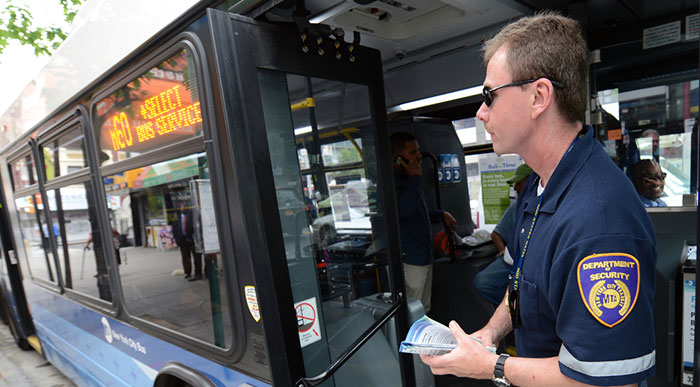File Photo
Comptroller Stringer’s SBS survey results indicate that the service shows, among other findings, “minimal improvement on glacial local bus routes.”
By Forum Staff
The City consistently fails to enforce bus lanes, which has led to persistently slow and unreliable Select Bus Service routes and contributed to significant rider dissatisfaction, according to a new “disturbing analysis” and survey of SBS riders released on Friday by City Comptroller Scott Stringer.
The City Department of Transportation and the Metropolitan Transportation Authority first introduced Select Bus Service in 2008, ostensibly to increase the speed, reliability, and appeal of bus service through the implementation of dedicated lanes, off-board fare collection, reduced stops, and Transit Signal Priority (technology which links approaching buses with traffic signals). Thus far, DOT and MTA have converted local routes to Select Bus Service along 15 corridors throughout the five boroughs, including the Q52/Q53 route along the Woodhaven Boulevard-Cross Bay Boulevard corridor. (This SBS path launched in November 2017 and was not included in Stringer’s analysis or survey.)
Yet despite the upgrades, SBS routes perform little better than local routes and offer riders little in the way of relief, according to the comptroller’s report. Stringer noted that the “alarming” analysis found average SBS route speeds only slightly faster than local routes (8.9 mph versus 7.4 mph), and on-time performance identical to local routes – 62 percent.
As a result, Stringer’s survey found that nearly 40 percent of riders graded SBS service a “C” or worse.
“If we’re going to build a real and rapid bus transit system in New York City, we need to do it right. No more half measures and cutting corners,” the comptroller said. “Right now, service is unacceptable, we need to do better – and our survey shows riders agree.”
This month, Stringer’s office polled 115 riders along 12 of the City’s 15 SBS routes. Among those surveyed:
• 70 percent flagged “traffic congestion on streets” as a key factor for SBS delays;
• 28 percent credited “vehicles blocking the bus lane/stop,” and
• 23 percent noted that “buses get stuck at multiple traffic lights.”
As a result, ridership reportedly has fallen on five of the nine SBS routes introduced prior to 2016.
Additionally, the comptroller’s survey found that 40 percent experienced difficulty obtaining a ticket at a SBS off-board fare payment machine in the last year. Among these riders, 77 percent reported that their Reduced-Fare MetroCard had not worked on multiple occasions and more than 15 percent reported issues on more than five occasions.
In the report, Stringer also offers recommendations for faster and more reliable bus service:
• The City should dramatically improve bus stop and bus lane enforcement;
• The State should authorize fixed-location traffic cameras along more routes in order to increase the enforcement of bus lanes;
• The City DOT should upgrade the design of bus lanes;
• The City DOT should expedite the implementation of Transit Signal Priority;
• The City and MTA should take a more “holistic” approach to bus enhancements citywide, Stringer suggested. High-frequency peak and off-peak service, all-door boarding, transit signal priority, curb extensions, efficient stop-spacing, and well designed, enforced, and strategically-located bus lanes should be characteristic of every local bus route, not just Select Bus Service, he said.

